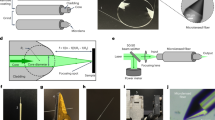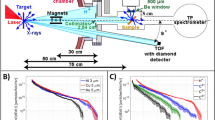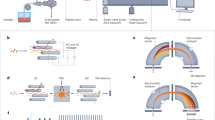Abstract
LASER microprobes currently in use combine a laser microscope with a light emission spectrometer1–3. Recent improvements in instrumentation have demonstrated the limitations of this method with respect to spatial resolution (some µm) and detection capability (10−13–10−15g). Much lower detection limits (10−18 g) have been obtained in ultrathin sections with electron probe X-ray microanalysers4,5, although the latter, however, do not satisfy many needs of biologists. Neither trace element detection in the parts per 109 range nor analytical information about organic constituents can be obtained. In the case of the main physiological electrolytes, biologists are primarily interested in the cellular and subcellular transport kinetics of Na+, K+, Mg2+, and Ca2+, indicating a need for microprobe techniques capable of analysing isotopes. A mass spectrometer in combination with a laser microprobe seems to be a very attractive approach. In principle, it should enable not only high sensitivity but also isotope analysis and the ‘fingerprinting’ of organic molecules, provided they do not decompose into fragments too small for recognition of the parent molecules. The special requirements for biomedical application are satisfied by the laser microprobe mass analyser (LAMMA) described here.
This is a preview of subscription content, access via your institution
Access options
Subscribe to this journal
Receive 51 print issues and online access
$199.00 per year
only $3.90 per issue
Buy this article
- Purchase on Springer Link
- Instant access to full article PDF
Prices may be subject to local taxes which are calculated during checkout
Similar content being viewed by others
References
Glick, D., in Modern Techniques in Physiological Sciences (edit. by Gros, J. F., et al.), 217–223 (Academic, London and New York, 1973).
Marich, K. W., in Microprobe Analysis as Applied to Cells and Tissues (edit. by Hall, T. A., et al.), 15–31 (Academic, London and New York, 1974).
Moenke, H. and Moenke, L., Laser Micro-Spectrochemical Analysis (Hilger, London, 1973).
Hall, T. A., in Physical Techniques in Biological Research, 1 A, (edit. by Oster, G., et al.), 157–275 (Academic, London and New York, 1971).
Hall, T. A., in Microprobe Analysis as Applied to Cells and Tissues (edit. by Hall, T. A., et al.), XV–XIX (Academic, London and New York, 1974).
Hillenkamp, F., Kaufmann, R., Nitsche, R., Remy, E., and Unsöld, E., ibid., 1–14.
Spurr, A. R., ibid., 213–227.
Dörge, A., Gehring, K., Nagel, W., and Thurau, K., ibid., 337–349.
Author information
Authors and Affiliations
Rights and permissions
About this article
Cite this article
HILLENKAMP, F., UNSöLD, E., KAUFMANN, R. et al. Laser microprobe mass analysis of organic materials. Nature 256, 119–120 (1975). https://doi.org/10.1038/256119a0
Received:
Accepted:
Issue Date:
DOI: https://doi.org/10.1038/256119a0
This article is cited by
-
Atmospheric pressure MALDI mass spectrometry imaging of tissues and cells at 1.4-μm lateral resolution
Nature Methods (2017)
-
3D Mass Spectrometry Imaging Reveals a Very Heterogeneous Drug Distribution in Tumors
Scientific Reports (2016)
-
Mass Spectrometry Imaging, an Emerging Technology in Neuropsychopharmacology
Neuropsychopharmacology (2014)
-
Implementation of a Gaussian Beam Laser and Aspheric Optics for High Spatial Resolution MALDI Imaging MS
Journal of the American Society for Mass Spectrometry (2014)
-
Mass spectrometry imaging with high resolution in mass and space
Histochemistry and Cell Biology (2013)
Comments
By submitting a comment you agree to abide by our Terms and Community Guidelines. If you find something abusive or that does not comply with our terms or guidelines please flag it as inappropriate.



